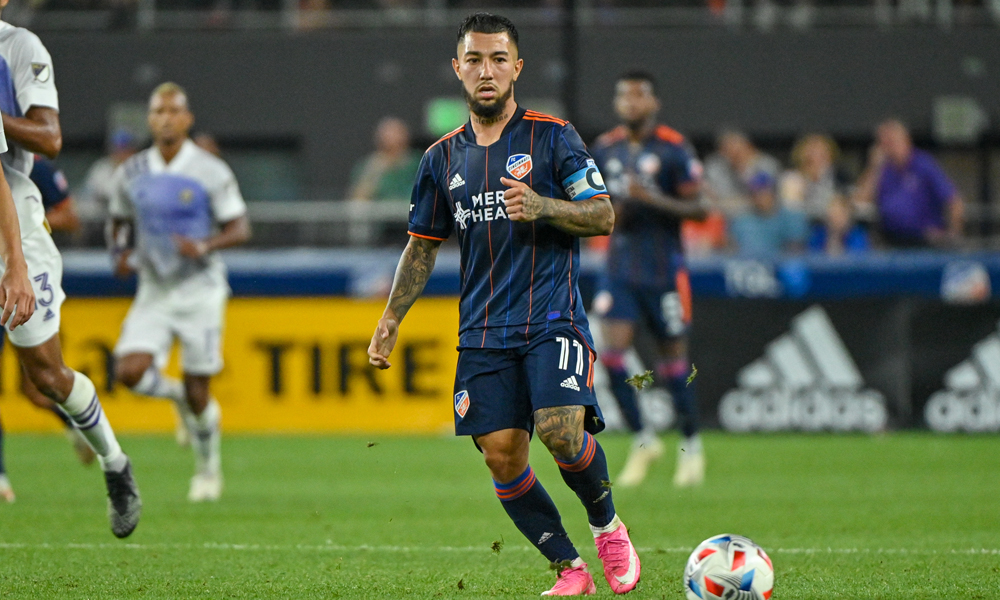Now that we’re a few weeks past the conclusion of FC Cincinnati’s 2021 season, it’s worth considering the season as a whole, even with how painful parts (or most or almost all) of it was.
In a press conference with local media, Albright noted that he wanted to create, “a sort of in-your-face, transition-based, pressing-based team that lends to the modern game and modern athlete and gives our fans something to embrace.” Given Albright’s history in Philadelphia and previous comments about how he would like the Orange and Blue to play, namely in a 4-4-2 diamond formation, assessing offseason needs and moves should be assessed with how well they fit into that long-term vision.
With initial roster decisions announced, the 2022 roster is a little clearer than it was a few weeks ago. If FCC will indeed favor a 4-4-2 diamond, many of the returning players on the roster seem like dubious fits. For instance, FCC’s roster is heavy on talented young wingers brought in under the previous regime looking to play in a 4-3-3. How Albright and FCC’s new head coach utilize those players will be of huge consequence in 2022. However, that’s a debate for another day.
Looking back on the 2021 season as a whole, there’s one particular area where FCC struggled, and with a couple of savvy moves this offseason along with a likely tactical change, the Orange and Blue could dramatically improve in 2022. I’m talking about ball progression.
What Happened In 2021
A major element of FCC’s offensive struggles in 2021 came down to a lack of ball progression. Simply, because the Orange and Blue lacked reliable options to move the ball from back to front, especially passing the ball, FCC was often trapped in its own half. That sounds obvious but the statistics bear it out.
In 2021, FCC finished 25th in MLS in successful entries into the final third – either a completed pass or dribble – and unsurprisingly ended the season averaging the fewest touches in the attacking third of the field per 90 minutes in the league with 125. Teams qualifying for the playoffs averaged nearly 157 per match. Again, it’s straightforward and pretty obvious (there are, of course, exceptions,) but teams that possess the ball more in their opponents’ defensive third of the field score more goals.

In 2021, opponents recognized FCC’s shakiness and pressured the Orange and Blue in its own defensive third at the fifth highest rate in MLS. There’s nothing fundamentally wrong with playing through a press. However, especially early in the season, FCC lacked either the technical ability or tactical nous to play through opponents’ pressure. Some of this is gameplan based. Before his departure, Jaap Stam emphasized a tactical approach built on playing out of the back, in some cases, seemingly at all costs. Without the necessary passers in midfield, FCC struggled to break pressure and then, even if the press was negated, to pick out the next pass to unlock a defense.
A Midfield Makeover
That’s why a revamp of the Orange and Blue’s midfield should be a top offseason priority.
FCC’s midfield is a major culprit in its ball progression woes. The issues really started in training camp with a roster seriously lacking midfield depth after the trade of Frankie Amaya to the New York Red Bulls. As has been widely covered, depth was such an issue that Yuya Kubo, an attacking player with an international pedigree with exactly zero professional minutes in defensive midfield, was suddenly FCC’s number one option at that position.
As noted above, FCC’s lack of progressive movement, especially passing, often left the Orange and Blue trapped in its own half. Whereas FCC finished at the bottom of the league in touches in attacking areas of the field, it ranked among league leaders in touches in its defensive third of the field, averaging 234 per 90 minutes.
Luciano Acosta, who, it should be noted, has no issues dropping deep to find the ball in the best of circumstances, was pulled further from goal to pick up possession as FCC was pinned in its own half. Frequently, Acosta was able to move the ball forward, however, he was the one passing the ball into dangerous areas rather than the one receiving it.
A top offseason priority for Albright should be bringing in midfielders who are competent ball progressors while at the same time, contributing the defensive work rate required in a 4-4-2 diamond. With Acosta playing as the furthest forward midfielder in that shape, he should have more opportunities to receive the ball higher up the field to set up strikers ahead of him.
FCC Analysis wrote a couple of very informative posts digging into how the Philadelphia Union utilizes its midfielders, including one specifically about how Philadelphia’s defensive midfield operates. FCC desperately needs a true #6. Bringing in a player who can cover ground, win the ball, and distribute up the field would greatly help the Orange and Blue on both sides of the ball. Based on his performance in 2021, Yuya Kubo seems like a good candidate to fill one of the two box-to-box roles on the sides of the diamond. Whether there’s currently another player who can play on the other side on the roster remains to be seen. However, the defensive midfielder should be the top priority.
Getting More From Fullbacks
Improving build up play won’t just come down to upgrades to FCC’s midfielder, however. Another priority for Albright and his team should be another option at right back.
Again, here’s where looking at Philadelphia can be instructive. Philadelphia’s fullbacks, Kai Wagner and Olivier Mbazio filled major roles in ball progression throughout the season, finishing first and second in progressive passes per 90 minutes. Consider the differences between the pairing Wagner and Mbazio versus FCC’s most common fullback pairing, Rónald Matarrita and Joe Gyau.

Clearly, Philadelphia’s pairing offered more in build up play. Rónald Matarrita demonstrated his ball progression bonafides on multiple occasions throughout the season and his track record extends to his previous tenure with NYCFC. Matarrita did not overlap on the left all that much in 2021, whether that was a result of a personal preference to stay narrower or a tactical decision isn’t clear. Pairing Matarrita with a shuttling 8 on the left side of the midfield diamond who is comfortable drifting wide to provide width in attack could make sense. It’s not a stretch to see a pairing of Yuya Kubo on the left side of a midfield diamond, given his previous experience playing as a winger, drifting out to provide width in the attack while Matarrita remains more central.
Right back is the real question mark. Zico Bailey, one of the two players whose contract option was picked up, provides FCC future upside and depth at the position at an excellent price, given he occupies a supplemental roster spot. However, a starting caliber right back should be near the top of Albright’s priority list. At right back for much of 2021, Joe Gyau was good with the ball at his feet but his passing did little to move FCC into attacking positions. The Orange and Blue should be looking for a right back who can provide width to the attack in the final third as well as be a wide option as FCC builds out from the back.
Adding able passers at the base of midfield and right back would help FCC play through pressure as well as unlock its more creative players higher up the field, putting them in situations to create scoring opportunities. These additions won’t solve everything but if FCC can improve in both spots, expect 2022 to be a more dangerous team going forward.













